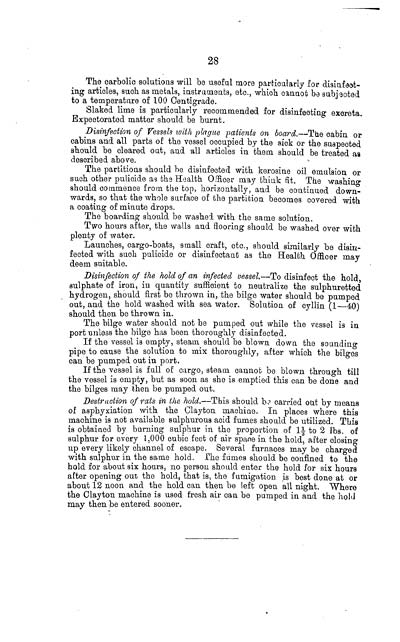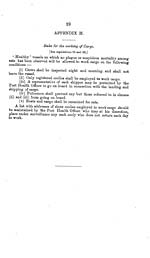Medicine - Disease > Madras marine plague regulations
(30) Page 28
Download files
Individual page:
Thumbnail gallery: Grid view | List view

28
The carbolic solutions will be useful more particularly for disinfect-
ing articles, such as metals, instruments, etc., which cannot be subjected
to a temperature of 100 Centigrade.
Slaked lime is particularly recommended for disinfecting excreta.
Expectorated matter should be burnt.
Disinfection of Vessels with plague patients on board.-The cabin or
cabins and all parts of the vessel occupied by the sick or the suspected
should be cleared out, and all articles in them should be treated as
described above.
The partitions should be disinfected with kerosine oil emulsion or
such other pulicide as the Health Officer may think fit. The washing
should commence from the top, horizontally, and be continued down-
wards, so that the whole surface of the partition becomes covered with
a coating of minute drops.
The boarding should be washed with the same solution.
Two hours after, the walls and flooring should be washed over with
plenty of water.
Launches, cargo-boats, small craft, etc., should similarly be disin-
fected with such pulicide or disinfectant as the Health Officer may
deem suitable.
Disinfection of the hold of an infected vessel.-To disinfect the hold,
sulphate of iron, in quantity sufficient to neutralize the sulphuretted
hydrogen, should first be thrown in, the bilge water should be pumped
out, and the hold washed with sea water. Solution of cyllin (1-40)
should then be thrown in.
The bilge water should not be pumped out while the vessel is in
port unless the bilge has been thoroughly disinfected.
If the vessel is empty, steam should be blown down the sounding
pipe to cause the solution to mix thoroughly, after which the bilges
can be pumped out in port.
If the vessel is full of cargo, steam cannot be blown through till
the vessel is empty, but as soon as she is emptied this can be done and
the bilges may then be pumped out.
Destruction of rats in the hold.-This should be carried out by means
of asphyxiation with the Clayton machine. In places where this
machine is not available sulphurous acid fumes should be utilized. This
is obtained by burning sulphur in the proportion of 11/2 to 2 lbs. of
sulphur for every 1,000 cubic feet of air space in the hold, after closing
up every likely channel of escape. Several furnaces may be charged
with sulphur in the same hold. The fumes should be confined to the
hold for about six hours, no person should enter the hold for six hours
after opening out the hold, that is, the fumigation is best done at or
about 12 noon and the hold can then be left open all night. Where
the Clayton machine is used fresh air can be pumped in and the hold
may then be entered sooner.
The carbolic solutions will be useful more particularly for disinfect-
ing articles, such as metals, instruments, etc., which cannot be subjected
to a temperature of 100 Centigrade.
Slaked lime is particularly recommended for disinfecting excreta.
Expectorated matter should be burnt.
Disinfection of Vessels with plague patients on board.-The cabin or
cabins and all parts of the vessel occupied by the sick or the suspected
should be cleared out, and all articles in them should be treated as
described above.
The partitions should be disinfected with kerosine oil emulsion or
such other pulicide as the Health Officer may think fit. The washing
should commence from the top, horizontally, and be continued down-
wards, so that the whole surface of the partition becomes covered with
a coating of minute drops.
The boarding should be washed with the same solution.
Two hours after, the walls and flooring should be washed over with
plenty of water.
Launches, cargo-boats, small craft, etc., should similarly be disin-
fected with such pulicide or disinfectant as the Health Officer may
deem suitable.
Disinfection of the hold of an infected vessel.-To disinfect the hold,
sulphate of iron, in quantity sufficient to neutralize the sulphuretted
hydrogen, should first be thrown in, the bilge water should be pumped
out, and the hold washed with sea water. Solution of cyllin (1-40)
should then be thrown in.
The bilge water should not be pumped out while the vessel is in
port unless the bilge has been thoroughly disinfected.
If the vessel is empty, steam should be blown down the sounding
pipe to cause the solution to mix thoroughly, after which the bilges
can be pumped out in port.
If the vessel is full of cargo, steam cannot be blown through till
the vessel is empty, but as soon as she is emptied this can be done and
the bilges may then be pumped out.
Destruction of rats in the hold.-This should be carried out by means
of asphyxiation with the Clayton machine. In places where this
machine is not available sulphurous acid fumes should be utilized. This
is obtained by burning sulphur in the proportion of 11/2 to 2 lbs. of
sulphur for every 1,000 cubic feet of air space in the hold, after closing
up every likely channel of escape. Several furnaces may be charged
with sulphur in the same hold. The fumes should be confined to the
hold for about six hours, no person should enter the hold for six hours
after opening out the hold, that is, the fumigation is best done at or
about 12 noon and the hold can then be left open all night. Where
the Clayton machine is used fresh air can be pumped in and the hold
may then be entered sooner.
Set display mode to: Large image | Zoom image | Transcription
Images and transcriptions on this page, including medium image downloads, may be used under the Creative Commons Attribution 4.0 International Licence unless otherwise stated. ![]()
| India Papers > Medicine - Disease > Madras marine plague regulations > (30) Page 28 |
|---|
| Permanent URL | https://digital.nls.uk/74589916 |
|---|




